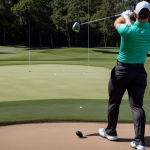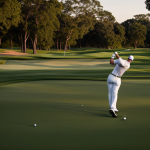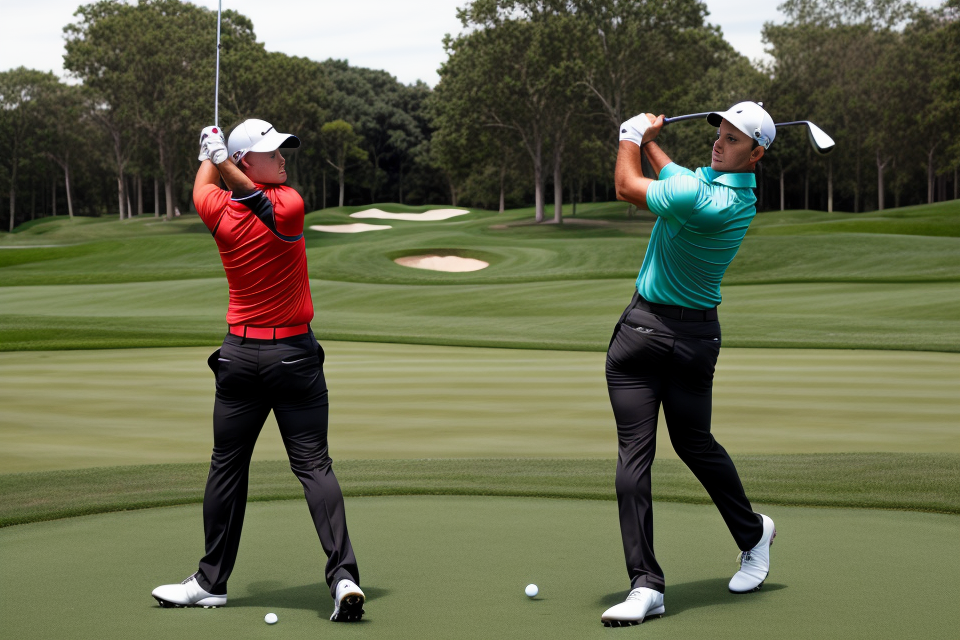Golf is a game that requires precision, accuracy, and speed. While many golfers focus on improving their accuracy and precision, speed is often overlooked. However, increasing your swing speed can help you hit the ball further and straighter, making it easier to reach the green and sink those all-important putts. In this comprehensive guide, we’ll explore how golf speed training works and what you can do to maximize your swing speed.
Golf speed training involves a range of exercises and drills designed to improve your power, strength, and overall physical fitness. By improving your physical capabilities, you’ll be able to generate more speed and power in your swing, resulting in longer and more accurate shots.
We’ll start by exploring the importance of having a proper golf swing technique, which is essential for generating speed and power. Then, we’ll delve into specific exercises and drills that you can do to improve your strength, power, and overall physical fitness. We’ll also look at how to incorporate these exercises into your golf training routine, so you can see real results on the course.
Whether you’re a beginner or an experienced golfer, this guide will provide you with the tools and knowledge you need to improve your swing speed and take your game to the next level. So, grab your golf clubs and let’s get started!
Understanding the Importance of Swing Speed in Golf
Factors Affecting Swing Speed
Swing speed is a crucial aspect of golf that can significantly impact the distance and accuracy of your shots. There are several factors that can affect your swing speed, including:
- Muscle strength and flexibility: Having strong muscles and good flexibility can help you generate more power and speed in your swing.
- Technique and mechanics: Proper technique and mechanics can help you optimize your swing speed and ensure that you are using your body and muscles efficiently.
- Equipment: The type of club you use can affect your swing speed, as well as the weight and flexibility of the shaft.
- Physical conditioning: Being in good physical condition can help you generate more power and speed in your swing, while being out of shape can slow you down.
- Mental state: Your mental state can also play a role in your swing speed, as feelings of anxiety or tension can cause you to swing too slowly, while feelings of confidence and focus can help you swing faster.
By understanding these factors, you can take steps to optimize your swing speed and improve your overall golf performance.
The Relationship Between Swing Speed and Distance
As golfers, we all know that the primary goal of the sport is to hit the ball as far as possible. And one of the most critical factors that determine how far the ball will travel is the swing speed of the golfer. The relationship between swing speed and distance is a complex one, but it is essential to understand if you want to improve your game.
The first thing to understand is that swing speed is not the only factor that affects distance. Other factors such as ball speed, spin rate, and launch angle also play a significant role. However, swing speed is the foundation upon which all these other factors are built. In other words, if you don’t have a fast swing speed, it will be difficult to achieve a high ball speed, spin rate, and launch angle, which are all necessary for maximizing distance.
The relationship between swing speed and distance can be broken down into two main components: ball speed and carry distance. Ball speed refers to the speed of the ball immediately after it is struck by the clubhead, while carry distance is the distance that the ball travels through the air before it begins to descend.
Research has shown that for every mph increase in swing speed, there is a corresponding increase in ball speed and carry distance. In other words, the faster you swing, the farther the ball will go. However, it’s important to note that this relationship is not linear. In other words, a small increase in swing speed may result in a more significant increase in distance than a larger increase in swing speed.
It’s also worth noting that the relationship between swing speed and distance is not the same for all golfers. Different players have different swing speeds and physical attributes, which can affect how they relate to the ball and the club. For example, a tall golfer with a long swing may be able to generate more distance than a shorter golfer with a shorter swing, even if their swing speed is similar.
In conclusion, the relationship between swing speed and distance is a complex one, but it is essential to understand if you want to improve your game. While other factors such as ball speed, spin rate, and launch angle also play a role, swing speed is the foundation upon which all these other factors are built. By increasing your swing speed, you can maximize your distance and become a more formidable force on the golf course.
Key Principles of Golf Speed Training
Focus on Fundamentals
- Golf speed training should begin with a focus on the fundamentals of the golf swing. This includes proper grip, stance, and alignment.
- Mastering these basic elements of the swing will provide a solid foundation for increasing swing speed and improving overall performance.
- It is important to understand that the golf swing is a complex motion that involves multiple joints and muscles. As such, it is essential to develop a comprehensive training program that addresses all aspects of the swing.
- A good starting point for developing a golf speed training program is to work with a qualified instructor who can provide guidance on proper technique and offer feedback on areas that need improvement.
- Regular practice and repetition are also crucial for developing muscle memory and building the necessary strength and flexibility for a powerful golf swing.
- It is also important to note that speed training should not come at the expense of accuracy. While increasing swing speed is desirable, it should not be done at the expense of control and precision. A balanced approach to training that emphasizes both power and accuracy is essential for success on the golf course.
Incorporate Speed-Building Drills
To increase your swing speed, it is important to incorporate speed-building drills into your practice routine. These drills are designed to improve your muscle memory, coordination, and overall power. By regularly practicing these drills, you can build strength and increase your swing speed.
Types of Speed-Building Drills
There are several types of speed-building drills that you can incorporate into your practice routine, including:
- Resistance Bands: Resistance bands are a great tool for building speed and power. They can be used to add resistance to your swings, which can help you build strength and increase your swing speed.
- Weighted Clubs: Weighted clubs are another effective tool for building speed and power. They can help you develop the muscles needed for a powerful swing, which can increase your swing speed.
- Explosiveness Drills: Explosiveness drills are designed to improve your power and speed. They can help you develop the explosiveness needed for a powerful swing, which can increase your swing speed.
- Rotational Drills: Rotational drills are designed to improve your rotation and overall power. They can help you develop the muscles needed for a powerful swing, which can increase your swing speed.
Incorporating Speed-Building Drills into Your Practice Routine
To effectively incorporate speed-building drills into your practice routine, it is important to follow these steps:
- Start with light weights or resistance bands, and gradually increase the weight or resistance as you get stronger.
- Practice the drills regularly, ideally at least three times a week.
- Focus on proper form and technique, and make sure to take breaks between sets to avoid fatigue.
- Incorporate the drills into your warm-up and cool-down routines to improve your overall performance.
By regularly practicing speed-building drills, you can build strength and increase your swing speed, which can help you hit the ball further and more accurately.
Utilize Resistance Bands and Other Equipment
When it comes to maximizing your swing speed, resistance bands and other equipment can be incredibly useful tools. These devices are designed to help golfers increase their strength, power, and speed, which can all contribute to a more powerful and effective swing. Here are some tips for utilizing resistance bands and other equipment in your golf speed training:
- Choose the right equipment: There are many different types of resistance bands and other equipment available, so it’s important to choose the right tools for your needs. Consider factors such as the resistance level, the type of exercise you want to perform, and your personal preferences when selecting equipment.
- Incorporate resistance bands into your warm-up: Resistance bands can be a great way to get your muscles warmed up and ready for a round of golf. Incorporate resistance band exercises into your pre-round warm-up routine to help increase your flexibility, mobility, and overall performance.
- Use resistance bands for strength training: Resistance bands can be used to perform a variety of strength training exercises that can help improve your swing speed. For example, you can use resistance bands to perform bicep curls, tricep extensions, and shoulder presses, which can all help build the strength needed for a powerful swing.
- Utilize other equipment for added resistance: While resistance bands are a great option for many golfers, there are other pieces of equipment that can provide added resistance and help you build strength. Dumbbells, kettlebells, and medicine balls are all excellent options for adding resistance to your workouts.
- Incorporate plyometrics: Plyometric exercises, such as jump squats and box jumps, can help increase your power and explosiveness, which can translate to a more powerful swing. Incorporate plyometric exercises into your workout routine to help improve your swing speed.
By incorporating resistance bands and other equipment into your golf speed training routine, you can help improve your strength, power, and speed, which can all contribute to a more effective and powerful swing.
Building Strength and Power for Increased Swing Speed
Exercises to Improve Explosiveness
Explosiveness is a crucial aspect of golf swing speed, as it enables golfers to generate power and transfer energy efficiently throughout the swing. To improve explosiveness, incorporate the following exercises into your training regimen:
- Plyometrics: Plyometric exercises involve rapid, explosive movements that develop power and improve speed. Examples include:
- Box jumps: Stand at the edge of a raised platform (such as a bench or box) and jump up, using the platform to propel yourself higher. Land softly and repeat.
- Depth jumps: Stand at the edge of a raised platform and jump off, descending rapidly to the ground. Land softly and repeat.
- Bounding: Run forward and leap into the air, bounding off the ground with each step.
- Resistance training: Strength training with weights or resistance bands can help develop muscular power. Focus on exercises that target the muscles used in the golf swing, such as:
- Squats: A compound exercise that targets the legs, glutes, and lower back, which are essential for generating power in the swing.
- Deadlifts: Another compound exercise that targets the posterior chain, including the hamstrings, glutes, and lower back.
- Explosive bench press: A variation of the bench press that emphasizes power over strict form, using explosive movements to lift the weight.
- Pistol squats: A challenging, single-leg squat that engages the muscles of the entire lower body. Performing pistol squats can help develop unilateral strength, balance, and stability, which are beneficial for golfers.
- Jump training: Incorporate jumps into your workout routine to enhance explosiveness. For example, add jumps to the end of each set of exercises, or perform jumps between stations during circuit training.
- Plyometric interval training: Alternate high-intensity plyometric exercises with short periods of rest to improve power and explosiveness. For instance, perform 30 seconds of box jumps followed by 30 seconds of rest, then repeat for 10-15 rounds.
Remember to maintain proper form during these exercises and gradually increase the intensity over time. Incorporating these explosiveness-focused exercises into your training regimen will help you develop the power necessary to increase your golf swing speed.
Developing Functional Strength for Golf
Functional strength is crucial for golfers as it directly affects swing speed and power. It involves targeting the muscles used in the golf swing, focusing on their strength and endurance. Here are some exercises that can help golfers develop functional strength:
1. Deadlifts
Deadlifts are an excellent exercise for developing lower body strength, which is essential for a powerful golf swing. It targets the glutes, hamstrings, and lower back muscles, which are all critical in generating power during the swing. To perform a deadlift, stand with your feet shoulder-width apart, grip the barbell with an overhand grip, and lift it off the ground by bending at the hips and knees. Lower the bar back down to the ground and repeat for the desired number of repetitions.
2. Squats
Squats are another excellent exercise for developing lower body strength, which is vital for a powerful golf swing. It targets the same muscles as deadlifts, but with a different emphasis on the quadriceps. To perform a squat, stand with your feet shoulder-width apart, lower your body by bending at the hips and knees, and then return to the starting position. You can also add weight to the exercise by holding a dumbbell or barbell.
3. Lunges
Lunges are a unilateral exercise that targets the muscles used in the golf swing, including the glutes, hamstrings, and quadriceps. It also helps improve balance and stability, which is essential for a smooth and powerful swing. To perform a lunge, step forward with one foot and lower your body by bending at the hips and knees. Push back to the starting position and repeat with the other leg.
4. Bulgarian Split Squats
Bulgarian split squats are a challenging exercise that targets the same muscles as lunges, but with an added balance challenge. It also helps improve single-leg strength, which is essential for a powerful golf swing. To perform a Bulgarian split squat, stand behind a bench or chair, and step back with one foot, lowering your body by bending at the hips and knees. Push back to the starting position and repeat with the other leg.
5. Core Exercises
Core exercises are essential for a stable and powerful golf swing. They help improve balance, posture, and rotation, which are all critical factors in a successful swing. Some effective core exercises include planks, Russian twists, and sit-ups.
By incorporating these exercises into your fitness routine, you can develop the functional strength necessary for a powerful and consistent golf swing.
Integrating Strength Training into Your Golf Practice
As golfers, we know that the strength and power we develop off the course can directly translate to increased swing speed on the course. But how do we integrate strength training into our golf practice in a way that maximizes our swing speed?
Here are some key considerations to keep in mind:
- Choose the right exercises: While any form of strength training can help improve your golf game, it’s important to choose exercises that specifically target the muscles used in the golf swing. Exercises such as squats, deadlifts, lunges, and bench presses can help build the power and strength needed for a faster swing.
- Incorporate resistance training: Resistance training is a great way to build strength and power. This can be done using free weights, resistance bands, or weight machines. Incorporating resistance training into your golf practice can help you develop the muscle memory needed to hit the ball further and faster.
- Focus on functional fitness: While it’s important to develop overall strength and power, it’s also important to focus on functional fitness. This means training the muscles used specifically in the golf swing, such as the glutes, hips, and core. Functional fitness exercises can include things like lateral lunges, Russian twists, and plank variations.
- Gradually increase intensity: It’s important to gradually increase the intensity of your strength training over time. This will help prevent injury and ensure that your body is able to adapt to the increased demands of your golf practice. Start with lighter weights and gradually increase the weight and intensity of your workouts over time.
- Incorporate plyometrics: Plyometrics are explosive exercises that can help develop power and speed. Examples include box jumps, depth jumps, and medicine ball slams. Incorporating plyometrics into your golf practice can help you develop the explosiveness needed to hit the ball further and faster.
By incorporating these key considerations into your strength training routine, you can maximize your swing speed and take your golf game to the next level.
Enhancing Your Swing Technique for Optimal Speed
Mastering the Golf Swing Motion
Understanding the Golf Swing Motion
The golf swing motion is a complex series of movements that require precise timing and coordination. To master the golf swing motion, it is important to understand the biomechanics of the swing and the different components that make up the motion.
Developing a Synchronized Swing Sequence
The golf swing motion is composed of several different movements that must be synchronized to achieve optimal speed and power. These movements include the takeaway, backswing, downswing, impact, and follow-through. To master the golf swing motion, it is important to develop a synchronized swing sequence that combines these movements into a seamless and efficient motion.
Developing a Proper Grip and Stance
A proper grip and stance are essential for mastering the golf swing motion. The grip should be firm but relaxed, with the hands positioned correctly on the golf club. The stance should be balanced and athletic, with the feet shoulder-width apart and the weight evenly distributed on both feet.
Incorporating the Correct Body Movements
To master the golf swing motion, it is important to incorporate the correct body movements. This includes using the correct muscles and joints in the right sequence, maintaining a smooth and fluid motion, and avoiding excessive movement or tension in the body.
Developing a Consistent Swing
To master the golf swing motion, it is important to develop a consistent swing that produces repeatable results. This involves establishing a proper tempo and rhythm, maintaining a steady swing speed, and avoiding any excessive or unnecessary movements that can disrupt the swing.
Practicing the Swing
To master the golf swing motion, it is important to practice regularly and consistently. This involves performing swing drills and exercises that focus on specific aspects of the swing, such as the takeaway, backswing, or impact. It is also important to practice under a variety of conditions, such as different wind speeds and golf course conditions, to develop a versatile and adaptable swing.
Seeking Professional Guidance
Finally, to master the golf swing motion, it may be helpful to seek professional guidance from a golf instructor or coach. A professional can provide personalized feedback and instruction tailored to your individual needs and swing style, and can help you develop a customized training program that maximizes your swing speed and power.
Common Swing Flaws and How to Correct Them
Golfers often struggle with common swing flaws that hinder their ability to maximize their swing speed. By identifying these flaws and correcting them, golfers can improve their overall swing technique and achieve greater distances on the course. Here are some of the most common swing flaws and the best ways to correct them:
Over the Top Swing
An over the top swing occurs when the golfer brings the club outside the plane of their swing and rotates their hands too much on the downswing. This flaw can lead to a loss of power and control, resulting in shorter distances and poor accuracy. To correct an over the top swing, golfers should focus on keeping their club inside the plane of their swing and using a more natural, shoulder-centric rotation.
Lack of Separation
A lack of separation occurs when the golfer fails to separate their hands and clubhead during the downswing, resulting in a loss of power and control. To correct this flaw, golfers should focus on keeping their hands ahead of the clubhead and maintaining a smooth, connected swing.
Casting
Casting occurs when the golfer fails to maintain a steady, controlled swing and instead rushes through the transition from backswing to downswing. This flaw can lead to a loss of power and accuracy, as well as increased fatigue and injury risk. To correct casting, golfers should focus on maintaining a smooth, steady tempo throughout their swing and avoiding any quick, jerky movements.
Slicing
Slicing occurs when the golfer fails to keep the clubface square to the target during the downswing, resulting in a loss of power and accuracy. To correct slicing, golfers should focus on keeping their clubface square to the target and using a more natural, shoulder-centric rotation.
By identifying and correcting these common swing flaws, golfers can improve their overall swing technique and maximize their swing speed. It’s important to remember that every golfer is unique, and what works for one player may not work for another. Therefore, it’s essential to work with a qualified golf instructor who can help identify and correct any swing flaws and develop a personalized training program that meets your individual needs and goals.
The Role of Biomechanics in Optimizing Swing Speed
Optimizing your swing speed is a critical aspect of improving your golf game. Biomechanics plays a significant role in enhancing your swing technique and maximizing your speed. Understanding the role of biomechanics can help you identify areas of improvement and make adjustments to your swing for optimal speed.
Biomechanics is the study of the mechanical laws governing the structure and function of living organisms, including humans. In the context of golf, biomechanics examines the mechanics of the body during the swing, including the movements of the joints, muscles, and tendons. By analyzing these movements, golfers can identify inefficiencies in their swing and make adjustments to optimize their speed.
One key aspect of biomechanics in golf is the relationship between the body and the golf club. The position of the body and the club during the swing can significantly impact the speed of the swing. For example, a proper grip on the club and a proper stance can help to maximize power and speed. Additionally, the use of the legs, hips, and torso can also affect the speed of the swing.
Another important factor in biomechanics is the use of the muscles. Different muscles are responsible for different aspects of the swing, and optimizing their use can lead to increased speed. For example, the glutes and hips play a critical role in generating power, while the rotator cuff and forearms are essential for maintaining control and accuracy.
In addition to the physical aspects of the swing, biomechanics also plays a role in mental aspects of the game. Golfers who understand the mechanics of their swing are better equipped to make adjustments and improve their performance under pressure. This understanding can also help to reduce injury risk and prevent common golf-related injuries.
Overall, the role of biomechanics in optimizing swing speed cannot be overstated. By understanding the mechanics of the body during the swing, golfers can identify areas of improvement and make adjustments to their technique for optimal speed and performance.
Improving Your Mental Game for Swing Speed Success
Cultivating a Positive Mindset
Understanding the Connection Between Mindset and Swing Speed
The connection between the mind and body is well-established in psychology, and it’s no different when it comes to golf swing speed. A positive mindset can help you maintain focus, build confidence, and reduce stress and anxiety, all of which can have a direct impact on your swing speed. By cultivating a positive mindset, you can improve your mental game and, as a result, increase your swing speed.
Developing a Pre-Shot Routine
One effective way to cultivate a positive mindset is to develop a pre-shot routine. This routine should include activities that help you get into a relaxed and focused state before each shot. For example, you might take a few deep breaths, visualize your shot, or mentally rehearse your swing. The goal is to create a routine that helps you get into a positive state of mind before each shot, so you can perform at your best.
Positive Self-Talk
Another key aspect of cultivating a positive mindset is using positive self-talk. This means replacing negative thoughts with positive ones. For example, instead of telling yourself “I always slice the ball,” try saying “I am making progress and getting better with each swing.” By using positive self-talk, you can build confidence and reduce negative thoughts, which can help you perform better on the golf course.
Visualization Techniques
Visualization techniques can also be helpful in cultivating a positive mindset. This involves mentally rehearsing your swing and visualizing the ball flying towards the target. By doing this, you can create a mental image of success, which can help you build confidence and reduce anxiety. You can also use visualization techniques to mentally prepare for challenging shots or situations, such as hitting from a difficult lie or dealing with strong winds.
Setting Realistic Goals
Finally, setting realistic goals can help you cultivate a positive mindset. This means setting goals that are challenging but achievable, so you can experience a sense of accomplishment when you reach them. For example, if you want to increase your swing speed, you might set a goal to add 10 mph to your current swing speed over the next six months. By setting realistic goals, you can maintain a positive attitude and stay motivated to improve your swing speed.
Visualization Techniques for Golf
Visualization is a powerful tool that can help golfers improve their swing speed by mentally rehearsing their swings before actually taking them. It involves creating a mental image of the perfect swing and repeating it in your mind.
Here are some techniques for visualizing your golf swings:
- Create a Mental Video: Close your eyes and imagine yourself making a perfect swing. See the clubhead moving through the air and feel the impact of the ball.
- Use All Your Senses: Try to involve as many senses as possible. For example, hear the sound of the clubhead hitting the ball, feel the wind on your face, and even smell the fresh cut grass.
- Repeat the Process: Repeat the visualization process several times before your actual swing. This will help you build a mental blueprint of the perfect swing.
- Practice Under Pressure: Practice visualizing your swing under pressure, just as you would during a real game. This will help you maintain focus and avoid choking under pressure.
By incorporating visualization techniques into your training routine, you can improve your mental game and increase your swing speed.
Managing Pressure and Nerves on the Course
Managing pressure and nerves on the course is a crucial aspect of improving your mental game for swing speed success. Golf is a mentally demanding sport, and the pressure to perform well can be overwhelming. However, with the right techniques and strategies, you can learn to manage your nerves and stay focused on the task at hand.
One effective technique for managing pressure on the course is to use visualization techniques. Visualization involves creating mental images of yourself performing well on the course, which can help you build confidence and reduce anxiety. For example, you can visualize yourself making a successful shot or holing a putt.
Another strategy for managing pressure is to focus on the process rather than the outcome. Instead of worrying about winning or losing, focus on executing each shot to the best of your ability. This can help you stay in the moment and avoid getting caught up in the pressure of the situation.
Additionally, it’s important to practice relaxation techniques, such as deep breathing and progressive muscle relaxation, to help you manage stress and stay calm on the course. These techniques can help you stay focused and energized, even in high-pressure situations.
Overall, managing pressure and nerves on the course requires a combination of mental toughness, focus, and relaxation techniques. By practicing these strategies, you can improve your mental game and increase your swing speed, allowing you to perform at your best on the course.
Integrating Golf Speed Training into Your Practice Routine
Assessing Your Current Skills and Limitations
When it comes to golf speed training, it’s important to assess your current skills and limitations before starting any program. This will help you to understand your strengths and weaknesses, and tailor your training to suit your individual needs. Here are some steps you can take to assess your current skills and limitations:
- Take a lesson: A professional golf instructor can help you to identify your strengths and weaknesses, and provide guidance on how to improve your swing speed. They can also provide feedback on your swing mechanics, and help you to develop a plan that is tailored to your individual needs.
- Use video analysis: Using video analysis can help you to identify areas of your swing that need improvement. You can record your swing and then review the footage with a coach or on your own. This can help you to identify any technical flaws or limitations that may be affecting your swing speed.
- Measure your current swing speed: Measuring your current swing speed can give you a baseline to work from. You can use a swing speed radar gun or a golf simulator to measure your current swing speed. This will help you to track your progress and see how your swing speed improves over time.
- Evaluate your physical fitness: Golf speed training requires a certain level of physical fitness, so it’s important to evaluate your current fitness level. You can measure your fitness level using a variety of tests, such as the beep test or the shuttle run. This will help you to identify any areas where you need to improve your fitness, and develop a training program that is tailored to your needs.
By assessing your current skills and limitations, you can develop a plan that is tailored to your individual needs. This will help you to maximize your swing speed and improve your overall golf performance.
Creating a Customized Training Plan
Creating a customized training plan is crucial for maximizing your swing speed. Here are some key steps to consider when creating your plan:
- Assess your current swing speed: The first step in creating a customized training plan is to assess your current swing speed. This will give you a baseline to work from and help you set realistic goals for improvement. You can use a golf swing speed radar or a stopwatch to measure your swing speed.
- Identify your weaknesses: Once you have assessed your current swing speed, identify any weaknesses in your swing that may be affecting your speed. This could include issues with your grip, stance, or swing mechanics.
- Choose exercises that target your weaknesses: Based on your assessment, choose exercises that target your weaknesses and will help you improve your swing speed. For example, if you have weak wrists, you may want to focus on wrist curl exercises.
- Develop a training schedule: Once you have identified the exercises you will be doing, develop a training schedule that you can stick to. This should include the frequency and duration of your workouts, as well as the specific exercises you will be doing.
- Gradually increase intensity: As you progress, gradually increase the intensity of your workouts. This could include adding more weight to your exercises or increasing the number of reps.
- Monitor your progress: Regularly monitor your progress to ensure that you are making progress towards your goals. This could include measuring your swing speed periodically or tracking your performance in golf tournaments.
By following these steps, you can create a customized training plan that is tailored to your specific needs and goals. This will help you maximize your swing speed and improve your overall golf performance.
Tracking Progress and Making Adjustments
Effective tracking of progress and making necessary adjustments are crucial steps in achieving optimal swing speed. To this end, golfers should consider the following recommendations:
- Establish measurable goals: Set specific, measurable goals that can be tracked over time. This can include aspects such as ball speed, clubhead speed, and distance. By having concrete goals, golfers can better monitor their progress and make necessary adjustments to their training regimen.
- Utilize technology: Modern technology, such as launch monitors and swing analyzers, can provide valuable data on various aspects of the golf swing. Golfers should regularly use these tools to gather data on their swings and track progress.
- Keep a swing journal: Maintaining a journal of swing observations and feelings can provide valuable insights into the golf swing. Golfers should document any changes in their swing, such as increased power or improved control, as well as any challenges or setbacks they encounter.
- Seek feedback from a coach or trained professional: An experienced coach or professional can offer valuable insights and guidance on how to improve swing speed. Golfers should regularly seek feedback from these individuals and incorporate their suggestions into their training regimen.
- Make adjustments based on data and feedback: Golfers should be willing to make adjustments to their training regimen based on data and feedback from coaches and technology. This may include altering exercises, incorporating new drills, or modifying swing techniques.
By diligently tracking progress and making necessary adjustments, golfers can maximize their swing speed and improve their overall performance on the golf course.
Overcoming Plateaus and Continuing to Improve
Identifying and Addressing Plateaus
When it comes to improving your swing speed, it’s important to understand that progress may not always be linear. You may reach a point where your speed begins to plateau, and you feel like you’re not making any further progress. This is a common experience for many golfers, and it’s important to recognize and address these plateaus in order to continue improving.
Here are some strategies for identifying and addressing plateaus in your swing speed training:
- Keep track of your progress: It’s important to have a clear understanding of your current level of performance and how it has changed over time. Keep a record of your swing speed measurements, and compare them to previous readings. If you notice that your speed has plateaued, it’s time to take action.
- Analyze your technique: If you’re not making progress, it’s possible that your technique needs some adjustments. Video analysis can be a helpful tool for identifying areas where you may be losing speed. Look for any compensations or weaknesses in your swing, and work on making corrections.
- Increase your training intensity: If you’ve been practicing at a consistent level and your speed has plateaued, it’s time to up the ante. Increase the intensity of your training by incorporating more challenging drills or exercises, or by practicing with heavier clubs. This will help to continue pushing your limits and increasing your swing speed.
- Seek feedback from a professional: If you’re really stuck, it may be helpful to seek feedback from a golf pro or instructor. They can provide an outside perspective on your swing and identify areas where you may be holding back or making compensations. With their guidance, you can develop a plan to continue improving your swing speed.
Adapting Your Training Program as Your Skills Evolve
As you progress in your golf speed training, it is important to adapt your training program to continue making improvements. Here are some tips for adapting your training program as your skills evolve:
- Reassess your goals: As you progress in your training, it is important to reassess your goals to ensure that they are still relevant and achievable. If your goals are no longer challenging, it may be time to set new goals or adjust your training program to continue making progress.
- Incorporate new exercises: As you become more proficient in your training, it is important to incorporate new exercises to continue challenging your body and improving your swing speed. Consider working with a golf fitness professional to develop a training program that includes a variety of exercises to target different muscle groups and improve overall golf performance.
- Increase intensity: As your skills improve, you may be able to increase the intensity of your training to continue challenging your body and improving your swing speed. This may include increasing the weight or resistance of your exercises, or adding new exercises that are more challenging.
- Focus on weaknesses: As you progress in your training, it is important to identify and focus on any weaknesses in your golf swing. This may include areas such as balance, rotation, or power. By focusing on these areas, you can continue to improve your overall golf performance and increase your swing speed.
- Monitor your progress: It is important to regularly monitor your progress to ensure that you are making improvements and to adjust your training program as needed. Consider tracking your performance using a swing analyzer or working with a golf coach to receive feedback on your swing. By monitoring your progress, you can make informed decisions about how to adapt your training program to continue making improvements.
Staying Motivated and Focused on Long-Term Goals
Staying motivated and focused on long-term goals is crucial for golfers who want to continue improving their swing speed. It can be easy to become discouraged when progress seems to have stalled, but by following a few key strategies, golfers can stay motivated and on track to achieving their goals.
Setting Clear and Realistic Goals
Setting clear and realistic goals is essential for staying motivated. Golfers should set specific, measurable, achievable, relevant, and time-bound (SMART) goals. For example, a golfer might set a goal to increase their swing speed by 5 mph in the next three months. By setting specific and measurable goals, golfers can track their progress and stay motivated to continue working towards their objectives.
Finding Inspiration and Accountability
Finding inspiration and accountability can help golfers stay motivated and focused on their long-term goals. Golfers can find inspiration by reading about successful golfers who have overcome plateaus and continued to improve their swing speed. They can also find inspiration by connecting with other golfers who are working towards similar goals. Additionally, finding an accountability partner, such as a golf coach or a friend who is also working on improving their swing speed, can help golfers stay on track and motivated.
Celebrating Small Wins
Celebrating small wins can help golfers stay motivated and build momentum. Instead of focusing solely on the ultimate goal of increasing swing speed, golfers should celebrate small wins along the way, such as hitting a personal best drive or increasing swing speed by 1 mph. By celebrating these small wins, golfers can build confidence and stay motivated to continue working towards their goals.
Reflecting on Progress and Adjusting Goals
Reflecting on progress and adjusting goals as needed is crucial for staying motivated and focused on long-term goals. Golfers should regularly review their progress and assess what is working and what is not. If progress has stalled, golfers should adjust their goals and strategies as needed to continue making progress. By reflecting on progress and adjusting goals, golfers can stay motivated and on track to achieving their objectives.
FAQs
1. What is golf speed training?
Golf speed training is a program designed to improve the swing speed of golfers. It typically involves exercises and drills that focus on developing strength, power, and speed in the muscles used during the golf swing. The goal of golf speed training is to increase clubhead speed, which can lead to longer drives and more accurate shots.
2. How does golf speed training work?
Golf speed training works by targeting the muscles used in the golf swing, including the legs, hips, core, and arms. The exercises and drills used in golf speed training are designed to improve muscle function and increase power output. By strengthening these muscles, golfers can develop more speed and control in their swings, leading to better performance on the golf course.
3. What are some examples of golf speed training exercises?
There are many exercises that can be used in golf speed training, including squats, lunges, deadlifts, and medicine ball slams. These exercises target the muscles used in the golf swing and help to improve strength, power, and speed. Golfers may also use drills such as weighted swing exercises, which involve swinging a weighted club to develop muscle memory and improve swing speed.
4. How often should I do golf speed training?
The frequency of golf speed training will depend on the individual golfer’s goals and schedule. However, most golfers will benefit from doing golf speed training exercises at least a few times per week. It’s important to allow adequate rest and recovery time between workouts to avoid injury and allow the muscles to adapt to the training.
5. Can golf speed training improve my overall golf game?
Yes, golf speed training can improve many aspects of a golfer’s game. By increasing swing speed and control, golfers can hit the ball further and more accurately. Additionally, strong muscles can help improve balance and stability, leading to better posture and more consistent swings. Overall, golf speed training can help golfers of all skill levels improve their performance on the golf course.








